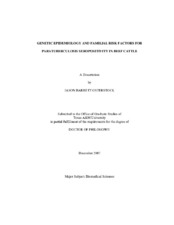| dc.contributor.advisor | Fosgate, Geoffrey T. | |
| dc.creator | Osterstock, Jason Barrett | |
| dc.date.accessioned | 2010-01-15T00:12:57Z | |
| dc.date.accessioned | 2010-01-16T00:32:52Z | |
| dc.date.available | 2010-01-15T00:12:57Z | |
| dc.date.available | 2010-01-16T00:32:52Z | |
| dc.date.created | 2007-12 | |
| dc.date.issued | 2009-05-15 | |
| dc.identifier.uri | https://hdl.handle.net/1969.1/ETD-TAMU-2435 | |
| dc.description.abstract | Paratuberculosis is an intestinal infection of ruminants caused by Mycobacterium
avium subsp. paratuberculosis (MAP). Genetic associations with paratuberculosis have
been described in Holstein cattle. The objectives were to describe the association
between paratuberculosis status of the dam and her offspring in beef cattle, develop
methods to assess familial aggregation of paratuberculosis in cattle of unknown
pedigree, and model the paratuberculosis status of beef cattle given familial and herdlevel
covariates. Texas beef cattle were tested for paratuberculosis using serum antibody
and microbiologic culture of feces. Available pedigree data were used to confirm
familial relationships.
The association between the paratuberculosis ELISA status of the dam and her
offspring was assessed using mixed-effects models. Increased odds of being classified as
a “suspect” or greater based on ELISA results were observed if the dam was classified as
a “suspect” or greater. A positive linear association was observed between the ELISA
value of the dam and her offspring. Analysis of pedigree data using conditional logistic regression identified ancestors associated with significantly increased odds of being
classified as “low positive” or greater.
Microsatellite markers were used to classify cattle into genetically similar groups
using allele frequency data. Nine clusters of genetically similar cattle were identified
among paratuberculosis test positive cattle, herd matched controls, and pedigreed cattle.
Clusters were validated using animals of known pedigree. Increased odds of
paratuberculosis seropositivity were observed for some clusters compared to the cluster
with the lowest seroprevalence.
A predictive model was developed using a Bayesian framework to assess the
association between antibody status of the dam and her offspring adjusted for herd-level
risk factors. Predictors associated with highly probable increased odds of seropositivity
included herd seroprevalence and herd fecal prevalence of MAP. The association
between dam and offspring ELISA status was small (OR 1.35) and not highly probable.
The results of this work support familial aggregation of paratuberculosis ELISA
status, but herd-level risk factors appear to be more important in predicting ELISA
status. A large proportion of observed serological reactions were not supported by fecal
culture results; therefore, observed associations might be limited to humoral responses to
Mycobacterium spp. | en |
| dc.format.medium | electronic | en |
| dc.format.mimetype | application/pdf | |
| dc.language.iso | en_US | |
| dc.subject | epidemiology | en |
| dc.subject | paratuberuclosis | en |
| dc.subject | beef cattle | en |
| dc.subject | genetics | en |
| dc.title | Genetic epidemiology and familial risk factors for paratuberculosis seropositivity in beef cattle | en |
| dc.type | Book | en |
| dc.type | Thesis | en |
| thesis.degree.department | Veterinary Integrative Biosciences | en |
| thesis.degree.discipline | Biomedical Sciences | en |
| thesis.degree.grantor | Texas A&M University | en |
| thesis.degree.name | Doctor of Philosophy | en |
| thesis.degree.level | Doctoral | en |
| dc.contributor.committeeMember | Cohen, Noah D. | |
| dc.contributor.committeeMember | Derr, James N. | |
| dc.contributor.committeeMember | Roussel, Allen J. | |
| dc.type.genre | Electronic Dissertation | en |
| dc.type.material | text | en |
| dc.format.digitalOrigin | born digital | en |


